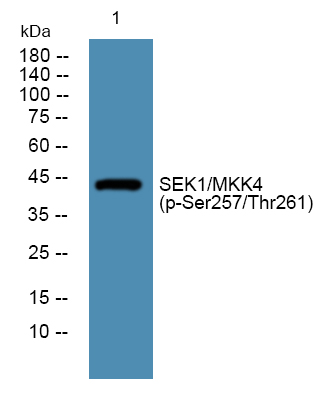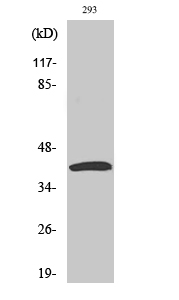SEK1/MKK4 (Phospho Ser257/Thr261) rabbit pAb
- Catalog No.:YP1481
- Applications:WB;ELISA;IHC
- Reactivity:Human;Mouse;Rat
- Target:
- MEK-4
- Fields:
- >>MAPK signaling pathway;>>ErbB signaling pathway;>>Toll-like receptor signaling pathway;>>Fc epsilon RI signaling pathway;>>TNF signaling pathway;>>GnRH signaling pathway;>>Relaxin signaling pathway;>>Growth hormone synthesis, secretion and action;>>Alcoholic liver disease;>>Epithelial cell signaling in Helicobacter pylori infection;>>Salmonella infection;>>Yersinia infection;>>Chagas disease;>>Hepatitis B;>>Human T-cell leukemia virus 1 infection;>>Kaposi sarcoma-associated herpesvirus infection;>>Epstein-Barr virus infection;>>Chemical carcinogenesis - reactive oxygen species;>>Lipid and atherosclerosis;>>Fluid shear stress and atherosclerosis
- Gene Name:
- MAP2K4 JNKK1 MEK4 MKK4 PRKMK4 SEK1 SERK1 SKK1
- Protein Name:
- SEK1/MKK4 (Ser257/Thr261)
- Human Gene Id:
- 6416
- Human Swiss Prot No:
- P45985
- Mouse Gene Id:
- 26398
- Mouse Swiss Prot No:
- P47809
- Immunogen:
- Synthesized phosho peptide around human SEK1 (Ser257 and Thr261)
- Specificity:
- This antibody detects endogenous levels of Human Mouse Rat SEK1/MKK4 (phospho-Ser257 or Thr261)
- Formulation:
- Liquid in PBS containing 50% glycerol, 0.5% BSA and 0.02% sodium azide.
- Source:
- Polyclonal, Rabbit,IgG
- Dilution:
- WB 1:500-2000;IHC 1:50-300; ELISA 2000-20000
- Purification:
- The antibody was affinity-purified from rabbit serum by affinity-chromatography using specific immunogen.
- Concentration:
- 1 mg/ml
- Storage Stability:
- -15°C to -25°C/1 year(Do not lower than -25°C)
- Other Name:
- Dual specificity mitogen-activated protein kinase kinase 4 (MAP kinase kinase 4) (MAPKK 4) (EC 2.7.12.2) (JNK-activating kinase 1) (MAPK/ERK kinase 4) (MEK 4) (SAPK/ERK kinase 1) (SEK1) (Stress-activated protein kinase kinase 1) (SAPK kinase 1) (SAPKK-1) (SAPKK1) (c-Jun N-terminal kinase kinase 1) (JNKK)
- Observed Band(KD):
- 44kD
- Background:
- This gene encodes a member of the mitogen-activated protein kinase (MAPK) family. Members of this family act as an integration point for multiple biochemical signals and are involved in a wide variety of cellular processes such as proliferation, differentiation, transcription regulation, and development. They form a three-tiered signaling module composed of MAPKKKs, MAPKKs, and MAPKs. This protein is phosphorylated at serine and threonine residues by MAPKKKs and subsequently phosphorylates downstream MAPK targets at threonine and tyrosine residues. A similar protein in mouse has been reported to play a role in liver organogenesis. A pseudogene of this gene is located on the long arm of chromosome X. Alternative splicing results in multiple transcript variants. [provided by RefSeq, Jul 2013],
- Function:
- catalytic activity:ATP + a protein = ADP + a phosphoprotein.,function:Dual specificity kinase that activates the JUN kinases MAPK8 (JNK1) and MAPK9 (JNK2) as well as MAPK14 (p38) but not MAPK1 (ERK2) or MAPK3 (ERK1).,PTM:Activated by phosphorylation on Ser/Thr by MAP kinase kinase kinases.,similarity:Belongs to the protein kinase superfamily.,similarity:Belongs to the protein kinase superfamily. STE Ser/Thr protein kinase family. MAP kinase kinase subfamily.,similarity:Contains 1 protein kinase domain.,subunit:Interacts with SPAG9.,tissue specificity:Abundant expression is seen in the skeletal muscle. It is also widely expressed in other tissues.,
- Subcellular Location:
- Cytoplasm . Nucleus .
- Expression:
- Abundant expression is seen in the skeletal muscle. It is also widely expressed in other tissues.
- June 19-2018
- WESTERN IMMUNOBLOTTING PROTOCOL
- June 19-2018
- IMMUNOHISTOCHEMISTRY-PARAFFIN PROTOCOL
- June 19-2018
- IMMUNOFLUORESCENCE PROTOCOL
- September 08-2020
- FLOW-CYTOMEYRT-PROTOCOL
- May 20-2022
- Cell-Based ELISA│解您多样本WB检测之困扰
- July 13-2018
- CELL-BASED-ELISA-PROTOCOL-FOR-ACETYL-PROTEIN
- July 13-2018
- CELL-BASED-ELISA-PROTOCOL-FOR-PHOSPHO-PROTEIN
- July 13-2018
- Antibody-FAQs
- Products Images

- Western blot analysis of lysates from K562 cells, primary antibody was diluted at 1:1000, 4°over night

- Immunohistochemical analysis of paraffin-embedded human Squamous cell carcinoma of lung. 1, Antibody was diluted at 1:200(4° overnight). 2, Tris-EDTA,pH9.0 was used for antigen retrieval. 3,Secondary antibody was diluted at 1:200(room temperature, 45min).


